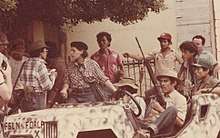Leticia Herrera Sánchez
Leticia Herrera Sánchez (born 11 March 1949) is a Nicaraguan politician and former guerrilla leader. She was one of the first women commanders of the Sandinista National Liberation Front (FSLN) against the dictatorial government of Anastasio Somoza in Nicaragua from 1974 to 1979.
Leticia Herrera Sánchez | |
|---|---|
| Deputy of the National Assembly of Nicaragua | |
| In office 1985–1996 | |
| Vice President of the National Assembly of Nicaragua | |
| In office 1985–1990 | |
| Personal details | |
| Born | 11 March 1949 Puntarenas Province, Costa Rica |
| Nationality | Costa Rican and Nicaraguan |
| Political party | Sandinista National Liberation Front |
| Alma mater | Peoples' Friendship University of Russia |
| Occupation | Lawyer, politician |
Early years
Leticia Herrera was born in Puntarenas Province, Costa Rica during the exile of her father, a Nicaraguan worker and syndicalist who was persecuted during Somoza's dictatorship.[1] She went through a large part of her primary and secondary education in Costa Rica where, at age 14, she had already formed a socialist organization at the institute where she studied.[2]
Militancy

Thanks to a scholarship, Herrera traveled to the USSR to study at what is now the Peoples' Friendship University of Russia in Moscow, where she graduated with a degree in law. During her time at the Soviet university, she was recruited by an FSLN cell in 1968 to join the Nicaraguan guerrilla movement.
Her participation required military training, for which she traveled to Lebanon to be instructed by the Palestine Liberation Organization. In 1970, she began her return to Nicaragua, passing through Italy, Spain, Mexico, Guatemala, and Honduras,[3] until in 1974, she joined Juan José Quezada's command.[4]
Once integrated into the unit, she was given the noms de guerre "Vichy" and "Miriam" in order to protect her identity.
That same year, she was one of the leaders of Operation December Victory, an assault on President Somoza's residence in which senior government officials were taken hostage. As a result of this raid, there were negotiations between the Somoza regime and the guerrilla command that led to the exchange of the officials for FSLN political prisoners. Its success was an important political victory for the FSLN, although the Sandinista Revolution would not take place until almost five years later.
Throughout her participation in the Sandinista Front, where she spent 10 years in hiding, Herrera performed multiple tasks, including being responsible for security of Daniel Ortega after his return to Managua following his release. A short time later, the politician would become the father of the second of Leticia's three children.[4]
Post-revolution
With the triumph of the FSLN, Leticia Herrera was removed from military work and reassigned to carry out literacy and health campaigns of the new regime, aimed at reducing infant and maternal mortality in Nicaragua.
From 1985 to 1996, she was a deputy of the National Assembly of Nicaragua, and was its vice president from 1985 to 1990.[5] She was head of the Sandinista Defense Committee, where she worked with regions, communities, and municipalities to develop brigades for health, literacy, and revolutionary vigilance.
In 2007, she was appointed by Ortega's government as consul of Nicaragua in Costa Rica, and was appointed consul in Panama in 2010.[6]
She was head of the Directorate of Alternate Conflict Resolution (DiRAC) until her dismissal in 2014.[7]
Works
- Guerrillera, mujer y comandante de la Revolución sandinista, memorias de Leticia Herrera (2013), Icaria, ISBN 9788498884944. A book in which the Nicaraguan offers her testimony and that of her companions about the transcendental role played by women in the armed conflict from a gender perspective.[3]
References
- Mariño, Henrique (17 October 2014). "Guerrilleras sandinistas: cuando las mujeres hicieron la revolución" [Sandinista Guerrillas: When Women Made the Revolution]. Público (in Spanish). Retrieved 17 September 2019.
- Núñez Jaime, Víctor (28 December 2014). "Leticia, la guerrillera". El País (in Spanish). Madrid. Retrieved 17 September 2019.
- Marrón, Núria (30 November 2014). "Comandante Leticia". El Periódico de Catalunya (in Spanish). Retrieved 17 September 2019.
- Sanchís, Ima (20 November 2014). "'Los guerrilleros con poder acosaban a sus compañeras'" ['The Guerrillas with Power Harassed Their Companions']. La Vanguardia (in Spanish). Retrieved 17 September 2019.
- Prado Reyes, Yader (16 May 2015). "Nicaragua: 58 años de participación de la mujer en cargos parlamentarios" [Nicaragua: 58 Years of Women's Participation in Parliamentary Positions]. El 19 Digital (in Spanish). Retrieved 18 September 2019.
- Bravo, Josué (9 July 2010). "Herrera ya no será cónsul en Costa Rica" [Herrera Will No Longer be Consul in Costa Rica]. La Prensa (in Spanish). Costa Rica.
- "Purga en el FSLN: Destituyen a comandante guerrillera Leticia Herrera" [Purge in the FSLN: Guerrilla Commander Leticia Herrera is Dismissed]. Nicaragua Hoy (in Spanish). 7 November 2014. Retrieved 17 September 2019.